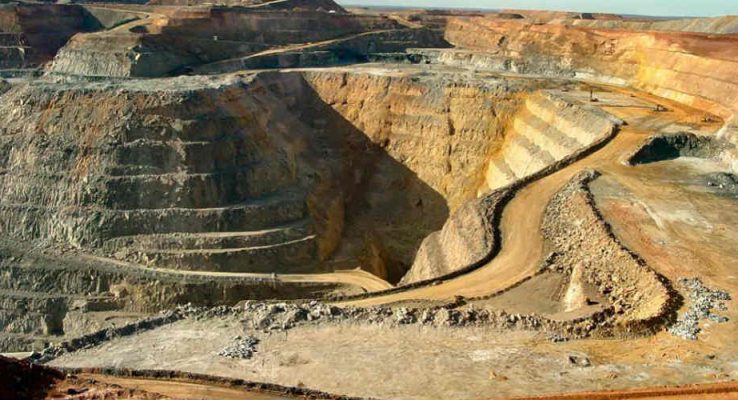Goldfield History
The Bendigo Goldfield is Australia’s second largest in terms of historical production after Western Australia’s Golden Mile.
Exploration and mining at Bendigo can be divided into three distinct phases:
- The first being the initial discovery and exploitation of the field from 1851 to the closure of the last underground mine in 1954.
- The second phase was the first serious attempt at modern exploration undertaken by WMC Ltd and Bendigo Mining between 1978 and 1993.
- This was followed by the third and current phase of exploration with the entire goldfield under the control of Bendigo Mining from 1993 to present day.
1851 to 1954
Alluvial gold was discovered along the banks of the Bendigo Creek in 1851 and resulted in a major gold rush. The discovery is usually attributed to Mrs Kennedy and Mrs Farrell, the wives of two of workers on the Mt Alexander North pastoral property. In Christmas 1851 there were 800 people on the field and by the following June, 20,000 diggers had arrived in the alluvial field. Alluvial gold production was dominant in the first ten years of the field to 1860 and is estimated to account for up to four million ounces or almost one fifth of the total gold won from the Bendigo Goldfield.
Sourcing the alluvial gold back to the quartz reefs was easily recognised and outcropping quartz reefs were soon brought into production. The appointment of government geologists from 1852 and the formation of the Geological Survey of Victoria in 1856 assisted in the rapid understanding of the controls of gold mineralisation.
The close association of all types of reefs with the anticline axis was recognised early in the development of the field. The reefs were found to be persistent along the anticlinal axes forming ribbons which repeated with depth. This early breakthrough in the predictability of ore gave mine management and investors confidence in the practice of deep shaft sinking on productive anticlines as the main exploration tool. Deep, often speculative, shaft sinking remained the pre-eminent exploration tool throughout the early productive life of the field (1851 to 1954).
Throughout the mining history of the Bendigo Goldfield in excess of 5,000 shafts were sunk (90 km of shaft sinking in total). At least 140 shafts exceeded 300 m in depth, 67 exceeded 600 m, and 11 were over 1,000 m deep. Shafts below 1000 m occur on three separate anticlines and the two deepest shafts are the New Chum Railway at 1,312 m deep and the Victoria Quartz at 1,406 m. Both shafts intersected significant gold mineralisation below 1 km depth. Despite this amount of shaft sinking the vast majority of the field is tested to depths of less than 200 m due to the physical and technical constraints on mining and exploration in the 19th Century. The Bendigo Goldfield represents the largest concentration of deep shafts anywhere in the world.
Historical Constraints on Exploration and Mining
Throughout the mining history of Bendigo there were a number of logistical and technical factors which severely constrained exploration and the profitable mining of gold.
Small size of individual leases
The combination of small leases and the great depths of mineralisation created problems in raising capital, limited the utilisation of expensive assets (shafts etc), reduced the chances of developing economies of scale and limited geological knowledge to a small fraction of the whole field. In addition the small leases restricted the exploration potential and increased the cost of exploration as companies could only continue to explore for new gold resources by continuing to deepen shafts, an expensive and time consuming form of exploration. These factors in turn dramatically increased the exploration risks faced by each company. At times the field supported as many as 1,300 separate companies with thousands of small mining leases.
Depth of Mineralisation
The depths of mineralisation at Bendigo placed some of the field at the leading edge of mining technology with shafts being the deepest in the world at that time. The depths involved in exploration and mining at Bendigo placed technical constraints on a company’s ability to explore and mine at ever increasing depths.
- Water: Though inflow rates were low, costs associated with pumping or bailing water were a major factor in profitability. Some mines closed prematurely when neighbouring, interconnected mines stopped dewatering forcing the remaining operations to cope with unmanageable inflow rates. It is noteworthy that most mines used bailing tanks rather than fixed pumps, due to depth and the relatively low inflows.
- Ventilation: This was a major constraint on mining in Bendigo. Air was introduced only by natural ventilation down the shaft. Raises or winzes connecting adjacent levels were required to increase air circulation and research suggests that air quality deteriorated to such an extent that most lower level development was restricted to within 100m of the shaft.
- Geothermal Gradient: The rate of increase in temperature with depth (1oF for every 90 ft of depth) is moderate to high at Bendigo and this temperature increase combined with poor ventilation was a major constraint in the deepest mines. Groundwater and air temperatures of 45oC were recorded at depths of 1,300 m.
Complex Mineralisation and Erratic Gold Distribution
The gold mineralisation, while metallurgically simple, can be geometrically complex often making it difficult to predict grade boundaries and ore occurrences on a local scale. Evidence of this is seen at the historical North Deborah Mine where miners stopped short of a potentially highly mineralised saddle reef after being confused by a false saddle reef.
Mineralisation within the Bendigo Goldfield is characterised by erratically distributed coarse gold. This extreme nugget effect makes it difficult to determine grade using a small sample charge assay technique such as fire assay. This problem was recognised early in the life of the field and a system of large-scale (20 t to 100 t) bulk sampling and visual identification of coarse gold was used to determine ore boundaries. Mining essentially involved continuous bulk sampling with individual parcels of ore treated separately through stamp batteries to give a running check on grade.
Capital
Capital raising was difficult due to the speculative nature of exploration and mining, competition from up to 1,300 companies on the field and the small size of individual leases. In addition the practice of paying almost all profit out in dividends often left companies short of working capital for future exploration and mine development.
Despite these constraints on exploration and mining, prospectors, miners, mine managers, geologists and investors were successful in locating, delineating and mining 18 Moz at an average head grade of 17 g/t of gold from reefs within the Bendigo Goldfield. They also achieved an average production rate in excess of 270,000 oz/y for the 60 years between 1854 and 1915.
The geological understanding of the field peaked in the period from 1900 to 1920 with a concentrated effort by government and company geologists to document the styles and controls of mineralised reefs. Papers by Rickard 1892, Cundy, 1916 and Pabst, 1919 were instrumental in developing the geological understanding of the field. With the waning of production from the 1920s much of this geological knowledge dissipated and was effectively lost.
In 1917 Bendigo Amalgamated Goldfield Ltd was formed from the amalgamation of 35 companies with operations on the Garden Gully, Sheepshead, Deborah and Derby lines of reef hoping to increase profits of these existing operations through economies of scale. This was difficult to achieve as the shafts involved were spread throughout the goldfield.
Diamond drilling and good geological practices were introduced (Pabst was Chief Geologist) leading to some exploration success. However costs were rising rapidly and in 1923 the directors, deciding that mining would soon become unprofitable, dissolved the company returning assets to the original vendors.
Mining was, once again given a boost for a period in the 1930’s. This was related to the higher price of gold and the discovery of significant new reefs on the Deborah line.
The 1930’s saw an attempt at large scale production by Bendigo Mines Ltd (a precursor to WMC) which undertook an extensive programme of development on the Nell Gwynne, Napoleon and Carshalton lines of reef. The venture met with little success as the assumption that opportunity in these areas was equal to the rest of Bendigo was not substantiated and it came to an end in 1937.
The Deborah line however proved profitable with the establishment of three successful mines which produced gold for nearly twenty years.
The closure of the Deborah Mines in 1954 ended over one hundred years of successful mining in Bendigo with the total production of gold of about 22 million ounces. The extent of the mining in Bendigo over this period is attested to by the fact that between 1938 and 1954 an estimated 500 shafts had been capped with concrete and a further 5,000 filled in.
1978 to 1993
WMC Ltd
The majority of exploration in this period was undertaken by WMC Ltd, who at that time controlled exploration and mining leases covering most of the field. WMC Ltd commenced exploration in 1978 and spent a total of $28 million over 14 years on exploration, research, underground development and installation of surface infrastructure including a small plant for bulk sampling (New Moon). They completed 45,000 m of diamond core drilling and 65,000 m of RC drilling and undertook an extensive compilation, consolidation and cataloguing of the available historical data.
Ultimately their exploration was unsuccessful in locating significant economic mineralisation and they withdrew from the goldfield. However their work was fundamental to the later exploration successes in the goldfield. The failure of the WMC Ltd effort can be attributed to three factors:
- Limited understanding of the structural/stratigraphic controls of gold mineralisation.
- Limited understanding of the sampling issues at Bendigo.
- Difficulties dealing with the local community and permitting issues.
Bendigo Mining 1993 to present
In the 1980s Bendigo Mining listed on the ASX with ownership of leases along the Deborah line of reef. In 1993, the Company consolidated ownership of the entire Goldfield when it purchased WMC’s interests. A detailed account of the recent history of Bendigo Mining is outlined in the Company History.







